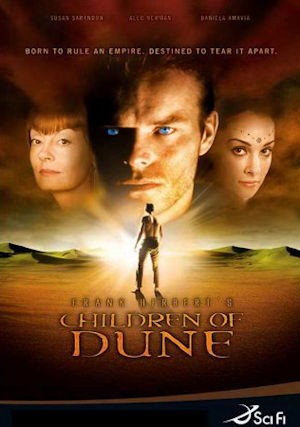Following the surprising triumph of 2000’s Frank Herbert’s Dune, the Sci-Fi Channel naturally returned to Arrakis with Frank Herbert’s Children of Dune in 2003. This sequel miniseries ambitiously adapted elements from Herbert’s Dune Messiah and Children of Dune, achieving even greater success than its predecessor and securing its place among the network’s highest-rated original programs. Boasting a larger budget while retaining much of the original cast and crew, 2003 Dune offered a sense of continuity alongside significant improvements in production quality.
Enhanced Production and Performances Elevate the Dune Saga
It’s undeniable that Children of Dune (2003) marks a significant step up in quality from the 2000 Dune miniseries. While occasional reminders of its TV movie origins persist, they are far less distracting. The sets are noticeably more elaborate and effectively conceal their limitations. The acting performances demonstrate a marked improvement in refinement, and the visual effects, while dated by today’s standards, represent a commendable effort for early 2000s cable television. Although some CGI elements—such as Alia’s combat drones, the desert tigers, and Leto’s enhanced speed—reveal their digital origins, they generally avoid resembling low-quality video game cutscenes from the late 90s. However, the writing, particularly in the concluding episode, doesn’t consistently reach the narrative heights established in the first miniseries.
The acting, however, is a clear highlight. Alec Newman returns as Paul Muad’Dib, delivering a compelling and nuanced performance. He captures poignant emotional depth, particularly in the first episode’s final scenes, and convincingly portrays the enigmatic Preacher. Daniela Amavia shines as Alia, Paul’s sister. She masterfully navigates the complexities of Alia’s descent into becoming an Abomination possessed by Baron Harkonnen. Ian McNeice reprises his spectral Baron Harkonnen, and while his performance remains theatrical, it feels more fitting in this context, perhaps because the rhyming dialogue is less frequent. New additions to the cast, Steven Berkoff as Stilgar (known for his role in Bond films) and Alice Krige as Lady Jessica (famously the Borg Queen in Star Trek), are welcome upgrades, bringing gravitas and skill to their roles.
James McAvoy’s Leto II: A Breakout Performance in 2003 Dune
The standout performance of 2003 Dune unquestionably belongs to James McAvoy as Leto II, Paul’s son and heir to the Atreides legacy. Early in his career, years before mainstream recognition in The Chronicles of Narnia and The Last King of Scotland, McAvoy displays remarkable maturity and talent. While his reliance on a sly grin to navigate emotionally complex scenes is occasionally noticeable, his overall presence and acting caliber feel a cut above many of his co-stars. Although visibly older than the character’s age in the books, this casting choice stems from writing decisions rather than McAvoy’s performance itself.
However, not all casting choices resonate as strongly. Susan Sarandon, portraying Wencisia Corrino, echoes William Hurt’s portrayal in the first miniseries by seeming somewhat lost within the Dune universe. Instead of Hurt’s stiffness, Sarandon opts for overt theatricality, delivering lines in an exaggerated style. Wencisia, a minor character in the Children of Dune novel, is significantly expanded in the miniseries, becoming a central figure even in the Dune Messiah adaptation portion of the first episode—a novel where she is entirely absent. Her subplot, largely separate from the core narrative, unfortunately evokes the lower production values of the original miniseries, featuring less impressive sets and lesser-known actors.
Adaptation Choices: Improvement and Deviation in the 2003 Miniseries
The numerous deviations from Frank Herbert’s source material in Children of Dune are a mixed bag. In the first episode, adapting Dune Messiah, these changes largely enhance the narrative. Wencisia’s integration into the conspiracy plot, for example, adds intrigue. The pacing feels more balanced, foreshadowing is clearer, and verbose dialogue from Dune Messiah is streamlined into tighter, more impactful sequences. While it’s debatable how well this episode serves viewers unfamiliar with the source material, as an adaptation, its writing is arguably stronger than much of either miniseries.
Unfortunately, the adaptation of Children of Dune in the final two episodes takes some questionable turns. Aging up Leto and Ghanima (though justifiable to cast James McAvoy) is a forgivable liberty. However, condensing a substantial portion of the book and altering character motivations and locations is more problematic. Alia’s dramatically heightened death scene, while more visually arresting than in the novel, comes at the cost of emotional depth and crucial plot explanations. Notably, the miniseries glosses over Jacurutu and Paul’s transformation into the Preacher, leaving gaps for viewers seeking fidelity to the books.
Conclusion: 2003 Dune – A More Engaging Chapter in the Dune Saga
Perhaps Frank Herbert’s Children of Dune would have benefited from a four-episode structure, allowing for a more comprehensive adaptation of the Children of Dune novel’s middle section, which contains much of the omitted plot details. This could have alleviated the rushed feeling and lack of exposition in the final episode. While writer John Harrison’s prior work on the original miniseries and the first episode is commendable, the constraints of condensing Children of Dune into two episodes may have been overly restrictive.
Regardless, Frank Herbert’s Children of Dune (2003) is a more enjoyable viewing experience than its predecessor. It fosters stronger emotional investment in the characters and plot, and its flaws are less distracting. The elevated production values and improved acting contribute to a more immersive experience. The four-hour runtime passes by engagingly, without inducing boredom. While imperfect, 2003 Dune stands as a commendable adaptation and possibly the best screen version of Frank Herbert’s complex universe to date.

